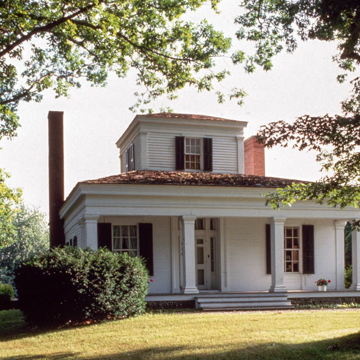Born in Canandaigua, New York, William Goodwin (1812–1896) immigrated to this farming community on the Kalamazoo River in 1845. Here he operated a mill and mercantile business. He served several terms in the state legislature and senate. Distinguished Jackson County builders built this diminutive wooden Greek Revival house for Goodwin and his first wife, Mary Granger, on the south bank of the river near his mill. The hipped roof of the single-story, cube-shaped house is topped with a square cupola that contains a single room with windows on all four sides. The main entrance to the house is recessed behind the flush-boarded front wall and is surrounded with side and transom lights. It is sheltered by a porch that runs across the front and that is supported by square Doric piers. Only a handful of small Greek Revival houses with a room at the top were built in south-central Michigan. They are distinctive to the region. Another is the Alfred and Ruth Eames Paddock House (1843) at 317 Hanover Street.
You are here
William F. and Mary Granger Goodwin House
If SAH Archipedia has been useful to you, please consider supporting it.
SAH Archipedia tells the story of the United States through its buildings, landscapes, and cities. This freely available resource empowers the public with authoritative knowledge that deepens their understanding and appreciation of the built environment. But the Society of Architectural Historians, which created SAH Archipedia with University of Virginia Press, needs your support to maintain the high-caliber research, writing, photography, cartography, editing, design, and programming that make SAH Archipedia a trusted online resource available to all who value the history of place, heritage tourism, and learning.











